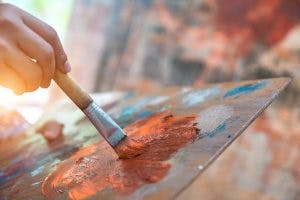Occupational Therapy Benefits of Performing String Art for Traumatic Brain Injury
In that location are many artistic ways to care for the secondary effects of a traumatic brain injury (TBI). Ane effective method is through art therapy.
Art therapy for brain injury patients is a not bad method for improving important mental skills and can fifty-fifty soothe emotional distress.
If you want to learn more than about this awesome therapy for TBI patients, keep reading!
Art Therapy for TBI Recovery
Art therapy for brain injury patients is a personalized therapy approach that helps strengthen cognitive function.
While art has helped people find peace and healing for millennia, it was merely in the mid-twentieth century that art was accustomed as a valid therapeutic approach to treating brain injury.
The great thing most fine art therapy is that it engages both the right and left hemispheres of the brain. In fact, in a recent MRI written report, researchers found that art activates both parietal lobes, the part of the encephalon that controls your depth perception and reasoning.
This has huge implications for brain injury patients, since one of the chief goals in TBI recovery is to stimulate the encephalon and activate neuroplasticity, the brain's natural machinery for healing itself.
The more you stimulate the brain, the more the brain forms neural pathways that repair the damage done to information technology. This means art tin can literally heal your encephalon.
Besides the fact that fine art therapy activates neuroplasticity, there are many other benefits that it offers for encephalon injury patients. We'll look at those in the department below.
Benefits of Art Therapy for Brain Injury Patients
The following are some of the best reasons to endeavour art therapy for brain injury.
i. Sharpen fine motor skills and visual perception

Handling pigment on a paintbrush can assistance you proceeds more control of your fingers and hands, which can transfer to other skills in your life, such as eating.
Working on fine details while painting also improves your hand-centre coordination. Plus, painting helps you develop stronger perception skills, since you'll need to larn how to make 2-D objects look 3-dimensional.
2. Amend concentration and attention
Art therapy, whether it involves painting, drawing, or taking a pottery class, requires heavy concentration.
You not but demand to concentrate on making a blossom the right shape, only you also take to keep in mind where it belongs in relation to the rest of the painting.
This will assistance y'all better your ability to focus for longer periods of time and teach y'all to keep more ane thing in your mind at once.
You might detect this hard at beginning, but the more you lot exercise, the easier it volition get.
iii. Boost problem-solving skills
Art might expect easy, merely it actually takes a lot of hard thinking.
Unless you're a natural artist, your painting is not going to come out perfectly on the outset try. This means you must know how to identify problems in your painting or cartoon and detect creative solutions.
Once again, this won't happen right away. You probably volition go frustrated a lot in the offset. But art therapy gives you a safe place to develop your trouble-solving skills and learn how to work with thwarting.
iv. Relieve symptoms of depression and build social skills

Fine art therapy is proven to help combat the chemical imbalances that cause depression.
Since depression is a major problem after brain injury, this is just one more reason why patients should give it a try.
Considering it frequently takes place in groups, art therapy also gives brain injury survivors a chance to rebuild their social skills and form friendships, which is key to making a good recovery.
five. Improve self-management and cocky-esteem
Ane of the best reasons to try art therapy later brain injury is it gives you a infinite where for once, you are in control.
You go to make up one's mind what to create, and how to create it. This helps y'all practise decision making and gives you back some autonomy, which volition also boost your self-esteem.
Do you want to paint a mural with grass and trees and mountains? Go ahead! Exercise yous desire to just accept fun and mix a bunch of colors together? You lot can do that too!
There are no wrong answers here; that's the beauty of art.
6. Increment mental flexibility and perseverance
Painting almost never goes the fashion y'all planned. You lot might run out of the right color, you might have used the wrong brush, or drawn things too big. Only if information technology doesn't look right, you tin't simply surrender; you need to figure out what to gear up.
Doing this frequently enough will help you lot develop more flexibility and creativity in the balance of your life also. You lot'll acquire non to get too attached to things, since when you're painting you always accept to exist prepared to wipe it out and start over.
In brusque, art therapy teaches you how to bargain with unexpected problems in a healthy fashion. All of that makes it a worthwhile activity for patients after brain injury.
7. Overcome emotional barriers

Sometimes it'due south hard to talk openly nearly your feelings, especially afterwards a brain injury. That's where art comes in.
Fine art therapy is a cathartic experience that lets y'all access feelings deep within your subconscious. It can help y'all piece of work through whatever emotional problems you might have in a constructive, non-threatening manner.
That's why so many psychologists prescribe fine art therapy to their patients suffering PTSD.
In fact, many patients find it helpful to express themselves through painting. They might apply colors to represent their feelings, or depict an image that means a lot to them.
Sometimes just the deed of immersing yourself in something else for a while, without having to worry near what others recall, is enough to save feelings of feet and anger.
Finding Hope through Art Therapy for Brain Injury Patients
As you can run into, art therapy offers many psychological and cerebral benefits for patients after a traumatic encephalon injury.
Non only does art activate neuroplasticity, it helps improve your mood, trouble-solving skills, attending, and coordination.
Well-nigh chiefly, art helps patients find a healthy outlet for their emotions, and rebuild their sense of self, something few other therapies tin can offer after a traumatic brain injury.
We hope this article inspires you to add fine art therapy to your life and discover hope afterwards your injury.
Source: https://www.flintrehab.com/art-therapy-for-brain-injury-patients/
Post a Comment for "Occupational Therapy Benefits of Performing String Art for Traumatic Brain Injury"